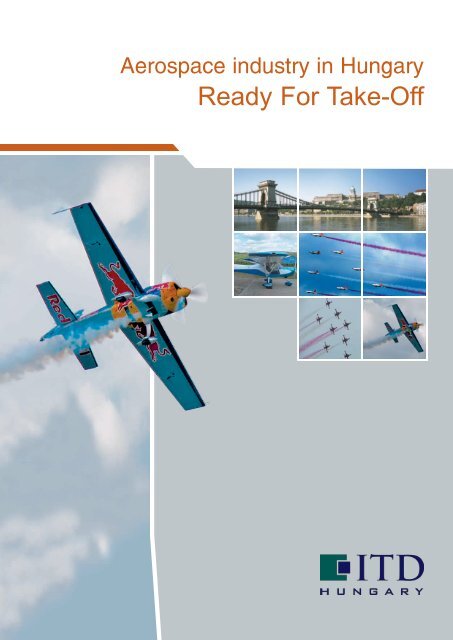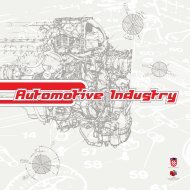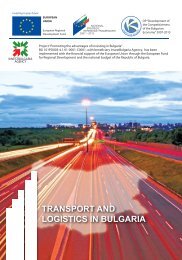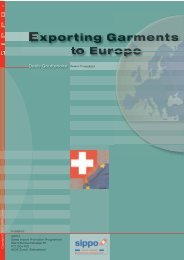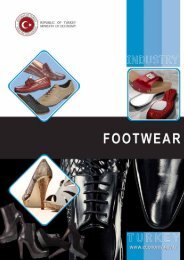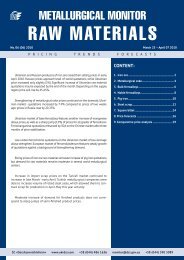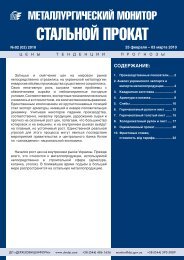Ready For Take-Off
Ready For Take-Off
Ready For Take-Off
Create successful ePaper yourself
Turn your PDF publications into a flip-book with our unique Google optimized e-Paper software.
Aerospace industry in Hungary<br />
<strong>Ready</strong> <strong>For</strong> <strong>Take</strong>-<strong>Off</strong>
History in a Nutshell<br />
Hungary’s aerospace industry can look back on rich traditions: several<br />
outstanding Hungarian aircraft designers and builders left their mark on<br />
the early history of aviation.<br />
The peace treaty following World War II, in which Hungary fought on the<br />
losing side as an ally of Germany, specified that aerospace development<br />
in Hungary would be restricted to prototypes of powered trainer<br />
aeroplanes and gliders.<br />
During the Communist era, little became public about the industry’s new<br />
developments, although Hungarian engineers played a significant role in<br />
the research and development of Soviet-made aircraft and supplementary<br />
equipment. Hungarian instruments and communication equipment have<br />
always been used extensively in space research and space flights.<br />
During the 1990’s Hungarian engineers and mechanics became more and<br />
more familiar with advanced methods of aircraft operation, maintenance<br />
and overhaul, and, by the end of the decade, a new group of aerospace<br />
experts had emerged proficient in English and knowledgeable of the<br />
Western methods of aerospace business.<br />
Starting with the year 2000, re-emergence of Hungarian aerospace<br />
began with the establishment of the first greenfield aerospace plant by<br />
GE Engine Services at Veresegyhaz, soon to be followed by Lufthansa<br />
Technik, ELDIM, ALCOA, Elektrometall GmbH and Flamespray. These<br />
companies have laid down the foundations for a new modern aerospace<br />
sector in Hungary. In the early 2000s, three new small aircraft design<br />
companies started operation. Using all-composite technologies, Corvus<br />
Aircraft Ltd., Composite One Ltd. and Waterfly Ltd. opened a new<br />
„composite era” in the history of the Hungarian aerospace industry.<br />
The Hungarian Aerospace industry (including MRO organisations)<br />
currently has more than 120 registered organisations and employs some<br />
2,100 people. The industry is 100% privately owned. The Hungarian<br />
Aviation Industry Foundation (HAIF - www.haif.org) was established in<br />
2003 with the aim of accelerating the industry development process.<br />
By organizing workshops, lobbying and bringing together aerospacerelated<br />
companies, HAIF initiated and organised the creation of the<br />
Hungarian Aerospace Cluster (HAC) in 2006, the first aerospace industrial<br />
group in Hungary focussing on development and manufacturing. HAC<br />
has 21 members at the time of writing, all of them in the private sector.<br />
The total number of employees of HAC members is more than 400.<br />
In September 2006, HAIF organized a third key organization called<br />
the Hungarian Aerospace Research Platform (HARP) to help research<br />
and development organisations in participating in FP7 Framework<br />
programmes. HARP currently lists 18 organisations, including two major<br />
universities.<br />
Established in 1993, the Defence Industry Association of Hungary<br />
(www.vedelmiipar.hu) also has several aerospace suppliers among its<br />
members.<br />
Milestones of Hungarian Aeronautics and Space Research<br />
Emil Némethy (1867-1943) was the first in the world to use steel tubes<br />
for aeroplanes and to apply aileron areas. The “Némethy-equation” was<br />
one of the first mathematical solutions to calculate with great precision the<br />
masslifting ability of early aeroplanes.<br />
Sándor Svachulay (1875-<br />
1955) built an aeroplane with<br />
welded steel tubes in 1909,<br />
which was a forerunner of the<br />
modern skeleton structured<br />
aeroplanes. <strong>For</strong> the aeroplane<br />
Albatros, Svachulay<br />
designed a retractable landing<br />
gear, which was later<br />
adapted by several international designers. His other inventions included<br />
the adjustable metal propeller and a device to control landing speed.<br />
János Adorján (1882-1964) was the designer and builder of Hungary’s<br />
first workable aeroplane. His two cylinder plane „Libelle” made several<br />
successful voyages in 1909-1910.<br />
Aladár Zsélyi (1883-1914)<br />
was the first in Hungary to<br />
design and build an aeroplane<br />
entirely based on structural<br />
engineering fundamentals. It<br />
included several new concepts<br />
including a new control<br />
mechanism and a spring supported<br />
landing gear.<br />
Tódor Kármán (1881-1949) is<br />
considered a leading theoretician of aero-dynamics. Kármán analysed the<br />
flow of fluid past a cylindrical obstacle at right angles and determined that<br />
the wake separated into two rows that create vibrations, as in aircraft wing<br />
flutter and a bridge in high wind. The concept, presented by him in several<br />
papers in 1911 and 1912, came to be called the „Kármán vortex street” or<br />
„Kármán vortices”. It led to the redesign of many structures to withstand<br />
oscillations and to modifications in the design of ships and aircraft to a<br />
streamlined shape. His theory on aerodynamic bumps served as a basis<br />
for the development of supersonic aircraft.<br />
Pál Vágó (1889-?) invented and developed the gyroscopic stabiliser, a forerunner<br />
of modern gyroscopic<br />
artificial horizons. In the first<br />
decades of modern aviation<br />
history, aeroplane designers<br />
seeking new flying techniques<br />
probed many different solutions;<br />
along with the rigidwing<br />
„dragon” or the ornithopter,<br />
they also experimented with<br />
propellers rotating around a vertical shaft. During World War I, Lieutenantcolonel<br />
István Petróczy, professor Tódor Kármán and Vilmos Zurovetz<br />
jointly made hovering experiments with a windmill plane, the PKZ.
Oszkár Asbóth (1891-1960) did<br />
military service at an aircraft<br />
factory near Vienna after the<br />
outbreak of World War I, where<br />
he was in charge of propeller<br />
manufacturing. He constructed<br />
and tested some 1,500 propellers<br />
in the factory’s wind tunnel.<br />
Ten years later, Asbóth built his<br />
first helicopter. Powered by a 120 HP nine-cylinder engine and propelled<br />
by two 4.35 meter propellers placed parallel above each other and rotating<br />
in opposite directions, the model „AH 1” took off vertically on September 9,<br />
1928.<br />
Dávid Schwartz (1845-1897),<br />
the Hungarian inventor of<br />
dirigible airship, used very<br />
thin aluminium to insulate the<br />
balloon, the aluminium skeleton<br />
and the propellers at the sides<br />
of the basket. Commissioned<br />
by the German army, he<br />
constructed the first dirigible<br />
airship in 1896, which was tested with partial success at Tempelhof near<br />
Berlin, Germany, on November 3, 1897. The propeller belts broke, causing<br />
the pilot to lose control and crash the airship. Schwarz died shortly afterwards.<br />
His widow sold all patent rights to Graf Zeppelin in 1898. Zeppelin went on to<br />
develop a successful line of dirigible airships which bore his name, while that<br />
of Schwartz’s sank into oblivion.<br />
Erno Rubik (1910-1997)<br />
was a member of a group of<br />
aircraft designers who were<br />
instrumental in rebuilding the<br />
Hungarian aircraft industry<br />
after World War I and II. In<br />
1956 as head of the Central<br />
Experimental Plant, he started<br />
to develop all-metal gliders<br />
with simple structures suitable for mass production. A family of all-metal gliders<br />
emerged, the most successful of which was the R-26 Góbé two-seater<br />
glider still in use for training purposes. In 1963, ‘Kossuth-Díj’, the highest<br />
Hungarian state award for science, was awarded to Erno Rubik for his lifetime<br />
achievement.<br />
The Space Technology Department of the Central Research Institute of<br />
Physics (KFKI RMKI) took an active part in the Soviet-lead Intercosmos<br />
international research programme. Vega 1 and 2 spacecrafts launched from<br />
Baikonur in December 1984 carried<br />
KFKI’s tracking and imaging systems<br />
and plasma particle detector and<br />
approached Halley’s Comet in March<br />
1986 from which it sent the first<br />
ever close-up pictures of a comet’s<br />
nucleus. KFKI’s instruments were<br />
also used at several other Russian<br />
and NASA and ESA co-ordinated projects. Recent Hungarian involvement in<br />
space research includes Rosetta, the MarsExpress and the VenusExpress.<br />
KFKI RMKI will supply a data ac-quisition and control system to the ISS<br />
Plasma Wave Complex due to be launched at the end of 2008, while another<br />
Hungarian supplier, SGF Kft., is involved in developing the project’s electronic<br />
ground support equipment.<br />
Why Hungary?<br />
Whether you are a producer looking for a new, cost-effective<br />
manufacturing base and new components or parts suppliers or a<br />
distributor of small aeroplanes – Hungary has much to offer.<br />
• Hungary is at the heart of Central and South-Eastern Europe, a region<br />
characterised by dynamic economic growth driven by high industrial<br />
output, excellent export potential and increasing domestic demand.<br />
• Hungary lies along the Eastern border of the EU and is within the<br />
Schengen zone. The country’s strategic position, highly developed<br />
logistics and ICT infrastructure and its traditional role as a trading<br />
post, makes it a natural service hub for the CEE region.<br />
• Well-trained, creative and flexible human capital at competitive cost:<br />
30-50% cost saving compared to Western Europe and the US. The<br />
average gross wage in Hungary is just €720 per month while labour<br />
productivity is one of the highest in the CEE region. The Hungarian<br />
labour force also rates highly in international comparisons for<br />
innovation and creativity, due to the country’s renowned standards of<br />
schooling and tertiary education.<br />
• Hungary, as a member of the European Union, fully harmonised its<br />
legal system with EU law including safety and quality regulations<br />
related to aerospace manufacturing, maintenance and aviation. The<br />
country also scores highly for data security and enforcement of<br />
intellectual property rights.<br />
• Business processes have been simplified considerably in recent<br />
years. In addition, foreign companies willing to settle in Hungary<br />
are welcomed with comprehensive trade development services and<br />
supportive government policy.<br />
• Globally recognised academic and university background. Increasingly,<br />
aerospace-related R&D activity is carried out in several universities<br />
and research institutions, making them potential partners for FP7 collaborative<br />
research.<br />
• Leading multinationals in the high-tech sector, such as GE, Alcoa,<br />
Lufthansa Systems, Honeywell, Nokia, Ericsson, Bosch, Philips and<br />
IBM, are already present in Hungary. They have also surrounded<br />
themselves with clusters of home-grown small and medium sized<br />
manufacturers and service suppliers.<br />
• A growing number of Hungarian companies designing and building<br />
small aeroplanes are looking for new sales opportunities and sources<br />
of high-tech materials and technologies.
Sector Overview<br />
Raw materials<br />
Hungary’s traditionally strong aluminium industry also supplies light-weight<br />
structures for vehicle manufacturing. Alcoa Hungary has recently launched a new<br />
airfoil casting plant, while US-based Zoltek makes Panex carbon fibre products in<br />
its plant at Nyergesújfalu.<br />
Components<br />
Hungarian automotive and electronic suppliers have been manufacturing<br />
high-quality products for international aerospace customers since the 1990s.<br />
Aerospace component manufacturing activity in Hungary was launched by<br />
foreign subsidiaries of Western aerospace companies including Hungaerotech,<br />
Elektrometall Paks, Alcoa-Köfém and Flamespray. Local companies soon<br />
joined them and, with the rapidly growing automotive industry in Hungary,<br />
there are more than 400 part suppliers covering a wide range of technologies<br />
and products (an increasing number also targeting the aerospace industry)<br />
throughout the country.<br />
As for the avionics sector, currently four companies are active in this industry<br />
including Elektrometall Kft. (also supplying wire-harnesses for the Airbus<br />
A320/380 models), Aviatronics Kft. and Bonn-Hungary Kft. (involved in<br />
communication technologies) and SGF Kft. (design and manufacture of black<br />
boxes and instrumentation for space missions).<br />
Composites<br />
Due to the growing popularity of composite structures in the aerospace industry,<br />
several Hungarian private companies including Flytech Kft. High Tech Composite<br />
Kft. and Composite One Kft. have become suppliers of local Austrian, German<br />
and US small aircraft manufacturers.<br />
Small aircraft development and manufacturing<br />
At the end of the 1990s, Eger-based Halley Kft. was the first company to<br />
come out with a powered Trike and the Apollo series. Soon, three new private<br />
companies followed suit with new small aircraft designs using composite<br />
technology: Composite One Kft., Corvus Aircraft Kft. and Waterfly Kft. The<br />
four aircraft developers, with the support of HAIF, established the Hungarian<br />
Aerospace Cluster in 2006.<br />
Design and engineering outsourcing<br />
After 2000, several young engineers graduating from Hungarian universities and<br />
using the most advanced 3D softwares embarked on international ventures. In<br />
2005, EDAG Hungary outplaced 15 young engineers to Hamburg to work on<br />
Airbus interior design. Today, dozens of EDAG engineers from Hungary work on<br />
the project. There are five engineering companies in the HAC cluster today.<br />
Special-tool design and rapid prototyping<br />
There are currently four or five companies with experience in the automotive<br />
industry and capable of designing and manufacturing special purpose machines,<br />
measuring devices, machine tools and assembling equipment and production<br />
lines for the aerospace sector. Rapid prototyping services are also available in<br />
Hungary, Varinex Ltd and Technoplast Ltd. provide various rapid prototyping<br />
services, finite element analysis, reverse engineering and 3D services.<br />
Maintenance, Repair and Overhaul<br />
The MRO sector employs the largest number of employees in the Hungarian aerospace<br />
sector. Authorised to service Airbus, Boeing and Fokker planes, both Aeroplex and<br />
Lufthansa-Technik provide line maintenance, repair and overhaul at Budapest Ferihegy<br />
Airport. GE Engine Service also repairs and maintains engines manufactured by parent<br />
company General Electric on a greenfield facility near the airport.<br />
Key industry pLAyers<br />
Research & Development<br />
• Admatis Kft. - www.admatis.com<br />
• Bay Zoltán Foundation for Applied Research - www.bayati.hu<br />
• Budapest University of Technology and Economics<br />
- Dept. of Aircraft and Ships - www.rht.bme.hu/<br />
- Dept. of Control Engineering and Information Technology<br />
- Department of Fluid Mechanics<br />
- Dept. of Mechatronics, Optics and Instrumentation<br />
Technology<br />
- Department of Control and Transport Automation<br />
- Department of Energy Engineering<br />
• Comergen Inc. - www.comergen.net<br />
• Miskolc University Department of Chemistry -<br />
www.uni-miskolc.hu<br />
• ODIN Budapest Kft. www.odinbudapest.hu<br />
• Research Institute for Technical Physics and Materials Science<br />
(MTA-MFA) - www.mfa.kfki.hu<br />
• SGF Kft. (Space & Ground Facilities Kft.)<br />
• Slot Consulting Kft. - www.slotconsulting.hu<br />
Small Aircraft Manufacturing / Composite parts<br />
• Composite One Kft. - www.compositeone.hu<br />
• Corvus Aircraft Kft. - www.corvus-aircraft.com<br />
• Flytech Kft.<br />
• Halley Kft. - www.halley.hu<br />
• HTC High Tech Composites Kft. - www.htc.info.hu<br />
• Hungarian Academy of Science, Research Inst. Physics and<br />
Material Science - http://www.mfa.kfki.hu/eng/<br />
• Idea Aircraft - www.ideaaircraft.com<br />
Aerospace-Related Design and Engineering<br />
• CAD-Terv Engineering Kft. - www.cadterv.hu<br />
• CFD Engineering Kft. - www.cfdengineering.hu<br />
• Delta-Tech Engineering Kft. - www.deltatech.hu<br />
• eCon Engineering Kft. - www.econengineering.com<br />
• H4 Aerospace Kft. - www.h4aerospace.com<br />
• Hilase Kft. - www.hilase.eu<br />
• Naturen Kft. - www.naturen.hu<br />
• Rea-Tech Kft.<br />
Parts Manufacturing and Rapid Prototyping<br />
• ABF Bowdentechnika Kft<br />
• Alcoa Fastening Systems Kft. -<br />
http://www.alcoa.com/hungary/hu/home.asp<br />
• Allied Visions Kft. - www.allied-visions.com<br />
• Anton Kft. - http://www.anton.zalaszam.hu/<br />
• Aviatronic Kft. - www.avia.kfkipark.hu<br />
• Bálind Kft. - www.balindceg.hu<br />
• BHE Bonn Hungary Kft. - www.bhe-mw.eu<br />
• BL-Electronics Kft. - www.bl-electronics.hu<br />
• Bódis Edelstahl-technik Kft - www.bodis-exhaust.hu<br />
• Borsodi Muhely Kft. - www borsodimuhely.hu<br />
• Calaluna United Technologies Zrt. - www.calaluna.hu<br />
• Cooptim Kft. - www.cooptim.hu<br />
• Dendrit Kft. - www.dendrit.hu<br />
• EDAG Kft.- www.edag.hu<br />
• Elektrometall Kft - www.eme-in.de<br />
• Eltec Holding - www.eltec.net<br />
• Flame Spray Kft. - www.flamespray.it•
• Gravitas 2000 Kft. - www.gravitas.hu<br />
• IT Ware Kft - www.itware.hu<br />
• K&K 95 Kft. - www.brakehose.hu<br />
• Magyarmet Precision Foundry - http://magyarmet.t-online.hu/mm<br />
• MTA-SZTAKI Distributed Systems - http://dsd.sztaki.hu<br />
• Niké-Mátra Kft.<br />
• Orion Electronics Kft. - www.orionelec.com<br />
• Ostorházi Kft. - www.ostorhazi.hu<br />
• SGF Kft. - www.sgf.hu<br />
• Simplesoft Kft. - www.simplesoft.hu<br />
• Sky Soft Kft. - www.sky-soft.hu<br />
• Hungarian Space Cluster - www.hunspace.org<br />
• Sotex Kft. -www.sotex.hu<br />
• Sulzer Hungaerotech Kft. - www.epicos.com/epicos/extended/<br />
hungary/hungaerotech/hungaerotech_home.html<br />
• Szimfék Zrt. - www.szimfek.hu<br />
• Technoplast Kft. - www.technoplast.hu<br />
• Varinex Informatics Zrt. - www.varinex.hu<br />
• Zoltek Zrt. - www.zoltek.com<br />
Maintenance<br />
• Aero-Kit Bt. - www.aerokit.fw.hu<br />
• Aerometal Kft. - www.aerometal.hu<br />
• Aeroplastic Kft.<br />
• Aeroplex Kft. - www.aeroplex.com<br />
• Agro-Aero 2000 Kft. - www.agroaero.hu<br />
• Base Kft. - www.baseairlines.hu<br />
• FARNAIR Hungary Kft. - www.farnair.com<br />
• GE Engine Services, Aviation - www.ge.com/hu/en<br />
• Hat&S Kft. Gyor - www.hats.hu<br />
• Kossuth Lajos Maintenance Traingin School<br />
• Lufthansa Technik Budapest Kft. - www.lht-budapest.com<br />
• Multiprojekt Kft. - www.multiprojekt-kft.com<br />
• Produktum Kft. - www.produktum.hu<br />
Maximum regional subsidy intensity rates<br />
Cash subsidy + tax allowance + any other state subsidy<br />
(excluding training subsidy) combined cannot exceed the<br />
maximum regional subsidy intensity rate for the given location.<br />
Maximum intensity rates vary between 25% and 50% depending<br />
on the state of development of the region.<br />
Investment Incentives<br />
The Hungarian Government offers two types of subsidy package for hightech<br />
manufacturing projects:<br />
I. Incentive package with EU co-financed cash grant - for investments<br />
up to EUR 25 million<br />
1. EU co-financed cash grant<br />
A non-refundable cash subsidy issued by the National Development<br />
Agency. The entire subsidy system is approved by the EU.<br />
ITD Hungary provides comprehensive and up-to-date information on<br />
open tenders on request.<br />
2. Development tax allowance<br />
• 80% of corporate income tax (currently at 16%, 19% from 2010) can<br />
be deducted for a period of up to 10 years<br />
• Minimum EUR 10 million investment with at least 150 new jobs created<br />
in developed regions and EUR 3.3 million with at least 75 new<br />
jobs in less developed regions<br />
3. Tender for job creation<br />
• Non-refundable<br />
• Amount of subsidy: HUF 0.8 million to HUF 1.5 million per created job<br />
(approx. EUR 2,700 – EUR 5,000)<br />
• Application period: March to April every year<br />
II. Incentive package granted on a case-by-case basis<br />
In cases where no EU co-financed subsidy is available, the Hungarian<br />
Government offers tailor-made incentive packages for high value-added<br />
projects with eligible costs exceeding EUR 10 million and generating<br />
at least 25 new jobs in less developed regions and more than 50 in<br />
developed regions. These incentives are offered as follows:<br />
1. Cash subsidies<br />
• Non-refundable subsidy defined as a percentage of eligible costs and<br />
based on an individual Government decision<br />
• Decision factors: investment volume, location of project, number of<br />
jobs created, ratio of graduates and wage-related costs<br />
• On receipt of all necessary project data, ITD Hungary will send an official<br />
incentive offer within 30 days<br />
2. Development tax allowance<br />
• 80% of corporate income tax (currently at 16%, 19% from 2010) can<br />
be deducted for a period of up to 10 years<br />
• Minimum EUR 10 million investment with at least 150 new jobs<br />
created in developed regions and EUR 3.3 million with at least 75 new<br />
jobs in less developed regions<br />
3. Training subsidies<br />
• From 25% to 90% of total training costs, depending on type of<br />
training and location of investment<br />
• Up to EUR 2 million<br />
• Granted above the maximum regional intensity rate<br />
4. Other incentives depending on location and direct job creation<br />
Please contact ITD Hungary for further information on available<br />
incentives and conditions.
Partnership Opportunities<br />
<strong>For</strong>eign companies are invited to be part of the revival of the Hungarian<br />
aerospace and aeronautics industry, in particular in the following areas:<br />
Training and consultancy<br />
• HAC members need regular updates and assistance for the implementation<br />
of the AS 9100 Quality Assurance Programme and the Design<br />
Organization Approval programme.<br />
• New prototypes recently developed will need type certifications from<br />
around the globe. This procedure also needs advisory assistance from<br />
experienced international consultancies.<br />
• Demand for small aeroplanes will generate a market for UL and LSA<br />
category aeroplanes. International co-operation will be needed for<br />
their maintenance and pilot training.<br />
Research & Development<br />
• With the establishment of the Hungarian Aerospace Research<br />
Platform, a new opportunity is offered for R&D co-operation with<br />
Hungarian institutions and enterprises in the FP7 Framework programme<br />
and the upcoming Clean Sky JTI programme.<br />
• The Hungarian Government provides cash subsidies and other incentives<br />
for the establishment of research and development centres in<br />
Hungary.<br />
Subcontracting<br />
• Machining and composite manufacturing offer the best potential for<br />
outsourcing products from Hungary.<br />
• Several aerospace engineering companies have launched initiatives<br />
in Hungary in recent years. These diversified companies are active in<br />
both the aerospace and automotive sectors. With Hungarian labour<br />
costs far below the EU average, these companies represent good<br />
opportunities for Western companies to outsource products and services<br />
in Hungary.<br />
Small aircraft supply<br />
• In the early 2000s, three new small aircraft design companies started<br />
operation. The production of Corvus Corone started in 2005 and the<br />
Composite One and the Waterfly amphibian prototypes are scheduled<br />
to start flight tests in 2008. Halley Kft. has produced more than a<br />
thousand “Apollo” UL-powered hang gliders and 50 Apollo Fox light<br />
aircraft since its foundation in 1980. To prove the reliability of the<br />
aircraft, Apollo Fox equipped with a Rotax 912ULS 100 Hp engine<br />
made a record-breaking 25,000 mile flight from Sármellék, Hungary to<br />
Sidney, Australia without any technical problem in 2003.<br />
Bonn Hungary converters,<br />
transceivers, amplifiers<br />
Model Corvus Corone<br />
Apollo final assembly<br />
Model Apollo Fox
CDMS of Rosetta Lander<br />
supplied by SGF Kft.<br />
Balaton Airport<br />
Jetstar<br />
The hangar at Lufthansa Technik Budapest<br />
Outsourced maintenance<br />
• Aeroplex provides third party maintenance services for several charter<br />
airlines. It has B737, B767, and Fokker 70 ’C’ check capability. It also<br />
plans to build new hangar capacity to cope with the growing demand<br />
for low-cost MRO services.<br />
• Dozens of small maintenance service providers throughout the country<br />
will need foreign capital and technological assistance to upgrade<br />
capacities and to improve service levels.<br />
Outsourced services<br />
• Hungarian engineering companies are rapidly expanding to the western<br />
market. EDAG Hungary outplaced 30 engineers to Hamburg to<br />
support Airbus projects in cabin interior work. The professional organisations<br />
of the Hungarian aerospace industry are seeking partnerships<br />
with western universities to establish joint ventures for postgraduate<br />
aerospace engineering training. <strong>For</strong>eign universities are invited to<br />
establish a CEE affiliate in Hungary which can provide cost-effective<br />
training to the industry.<br />
• Hundreds of highly skilled Hungarian companies in the ICT sector are<br />
available • for contract programming, software integration and other<br />
communications and information technology services.<br />
Airport development<br />
• There are more than 70 airports in Hungary, but only a few are currently<br />
suitable for international traffic. <strong>For</strong>eign airport operators are<br />
invited to help develop secondary and regional airports for freight and<br />
civilian use.<br />
• In the coming years, major investments will transform Budapest<br />
Airport into Central Europe’s leading air transport hub. More that €250<br />
million has been earmarked to boost passenger and freight traffic<br />
and upgrade related airport services, logistics and tourist facilities<br />
by 2011. In terms of freight transport, the airports at Sármellék,<br />
Taszár, Debrecen and Mezõkövesd have been singled out for further<br />
expansion and development.
A one-stop shop for investors<br />
ITD Hungary (www.itd.hu) is the Hungarian government’s Investment<br />
and Trade Development Agency, established by the Ministry of Economy<br />
and Transport, to promote inward investment and bilateral trade. With<br />
representative offices in eight regional centres of Hungary and a foreign<br />
network operating under Hungary’s diplomatic services at 55 offices in 43<br />
countries, ITD Hungary is a single point of contact to support decisionmakers<br />
looking for investment and trade opportunities in Hungary. The<br />
Agency provides foreign investors with high-quality support for key decisionmaking<br />
processes and a wealth of supplementary services.<br />
proJeCt prepArAtion<br />
• In-depth, tailored information on the local economy and business climate,<br />
corporate taxation and the legal environment, as well as sector-specific<br />
overviews<br />
• Site visits, meetings with local, regional and government bodies and<br />
introductions to local suppliers, service providers and experts<br />
• Information on available incentives<br />
iMpLeMentAtion<br />
• Site selection assistance, coordination of licencing procedures<br />
• Finalisation of incentives agreements<br />
• Assistance with recruitment and visa application<br />
• VIP treatment for expatriate employees<br />
After-CAre<br />
• Intermediary role for future developments between government bodies<br />
and companies operating in Hungary<br />
• Support and generation of reinvestments<br />
for more information please contact:<br />
Mr. András Wittek, Consultant, andras.wittek@itd.hu<br />
Mr. Tamás Katona, Consultant, tamas.katona@itd.hu<br />
ITD Hungary - The Hungarian Investment and<br />
Trade Development Agency<br />
Address: Andrássy út 12<br />
H-1061 Budapest, Hungary<br />
Phone: +36 1 472 8100 • Fax: +36 1 472 8180<br />
E-mail: investment@itd.hu • www.itd.hu


